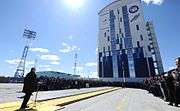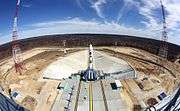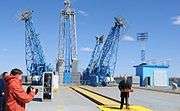Vostochny Cosmodrome
 | |
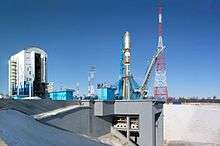 Soyuz-2.1a from Vostochny | |
| Agency overview | |
|---|---|
| Formed | August 1, 2011 |
| Jurisdiction | Government of Russia |
| Headquarters |
Tsiolkovsky, Amur Oblast 51°53′04.39″N 128°20′05.2″E / 51.8845528°N 128.334778°E |
| Parent agency | Roscosmos |
| Map | |
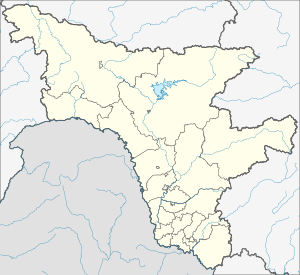 Location in Amur Oblast | |
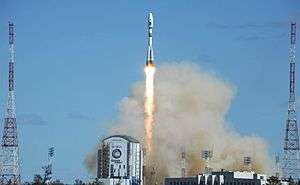
The Vostochny Cosmodrome (Russian: Космодром Восточный Kosmodrom Vostochny "Eastern Spaceport") is a Russian spaceport under construction on the 51st parallel north in the Amur Oblast, in the Russian Far East. When completed in 2018 at an estimated cost of $7.5 billion USD, it is intended to reduce Russia's dependency on the Baikonur Cosmodrome in Kazakhstan. The first launch took place on 28 April 2016 at 02:01 UTC. As of February 2018, three rockets were launched from the cosmodrome, including one that failed.[1]
Location
Vostochny (which means "eastern" in Russian) is in the Svobodny and Shimanovsk districts of Amur Oblast in the Russian Far East, on the watershed of the Zeya and Bolshaya Pyora rivers,[2] approximately 600–800 km (370–500 mi) from the Pacific Ocean, depending on launch azimuth. The planned total area is 551.5 km2, being a region approximately 30 km in diameter centred on 51°53′04″N 128°20′02″E / 51.884395°N 128.333932°ECoordinates: 51°53′04″N 128°20′02″E / 51.884395°N 128.333932°E.[3] The nearby train station is Ledyanaya and the nearest city is Tsiolkovsky. The cosmodrome's latitude, 51° north, means that rockets will be able to carry almost the same amount of payload as they can when launched from Baikonur at 46°N.[4] Other arguments for choosing this location include the ability to use sparsely populated areas and bodies of water for the rocket launch routes; proximity to major transportation networks such as the Baikal–Amur Mainline, the Chita–Khabarovsk Highway; abundance of electricity production resources in the area; and the infrastructure supporting the former Svobodny Cosmodrome, on which the new spaceport will be based.[2] The site's location in the Russian far eastern region allows for easier transport of materials to the site, and allows rockets to jettison their lower stages over the ocean.[5] It was expanded as part of the plan of modernization of the supporting infrastructure. Putin said that among places offered was an area on the shore of the Pacific Ocean, near Vladivostok, but that experts recommended not to locate it there since the proximity to the ocean can create problems and delays in launches, and as a result the current place was chosen.[6]
History
Russian president Vladimir Putin made several statements emphasizing the importance of the new cosmodrome. In August 2010, he said, "The creation of a new space center ... is one of modern Russia's biggest and most ambitious projects".[7] In January 2011, he ordered the government to complete the paperwork as soon as possible so that construction can start on schedule.[8]
The general designer of the cosmodrome is Ipromashprom (Mechanical Engineering Project Institute). The main contractor is the Federal Agency for Special Construction.[2]
Construction of the cosmodrome began in January 2011 and, as of 2011, was expected to be completed in 2018.[9]
During a visit to the site in July 2011, the newly appointed chief of Roscosmos, Vladimir Popovkin, promised 20 billion rubles for Vostochny during 2012.[10] A month later, the head of Spetstroy, Grigory Naginsky told the press that the first blueprints for the center went through the project expertise and the first contract worth 1.6 billion rubles was signed with Roscosmos, covering the construction of the railway line and the road. Naginsky also promised the completion of the initial makeshift housing for construction workers at the site by 1 October 2011.
Although the Angara pad at Vostochny had originally been planned for completion in 2018, as part of the second phase of the construction of the new launch center, Dmitry Rogozin announced in January 2013 that Angara would fly from Vostochny earlier, in 2015.[11] In the event, however, Roscosmos announced in November 2014 a postponement, and that the first unmanned test mission of Angara would not launch until 2021.[11]
Over 100 construction workers went on strike to protest about unpaid wages in March and April 2015.[12] Following corruption allegations and findings by the Russian Prosecutor General's Office that "a number of labor laws have been violated during the construction. [Vladimir Putin said he is] taking personal control of the cosmodrome's construction."[13]
In June 2015, the installation of the support equipment, assembly of the first floor of the command post of the Vostochny Cosmodrome have been handed over to specialists of the Centre for Operation of Space Ground-Based Infrastructure (TsENKI).[14]
In October 2015, it was announced that parts of the assembly complex for the Soyuz-2 rocket were designed for a different variant of the rocket and are too small, so that the planned launch date of the first Soyuz-2 from Vostochny Cosmodrome in December 2015 was under question.[15] A spokesperson for a Russian government space infrastructure agency reported that "Work with the rocket at the integration and testing complex now can not be conducted because the facility is not ready", and added that "there are still imperfections in the construction".[16] However, later this information was disproved by the cosmodrome's operation centre and the rocket was set into the facility.[17]
Construction
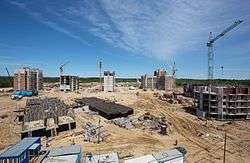
_2.jpg)
Early plans project seven launch pads will be built at the site, including two for crewed flights. On 1 September 2009, Medvedev signed Presidential decree №562 declaring Spetstroy is the sole contractor of the construction of the cosmodrome.[18] Construction began in January 2011[19] and is expected to be completed by 2018.[20][21] The first launch took place on 28 April 2016. Russian engineers are looking to apply the knowledge gained from building the Soyuz launch facilities in Kourou spaceport and the Angara pad at Naro Space Center in South Korea.[19] As a cost-saving measure, no defensive military structures like those at Baikonur cosmodrome will be built at Vostochny.[8] More than 400 social, engineering and transport infrastructure facilities, 115 km (71 mi) of roads and 125 km (78 mi) of railroads are projected to be built at the cosmodrome.
In December 2011, ARMS-TASS reported with reference to the director of Federal Special Construction Agency, Grigory Naginsky that the hotels and barracks were being constructed within the infrastructure of Vostochny Cosmodrome. Speaking of housing development plans, he noted that a town for 40 thousand people would be constructed in the network of Cosmodrome.[22]
In January 2012, a Russian Government Decree signed by Prime Minister Medvedev transferred 9,663 hectares (23,880 acres) of forest lands in the Amur Oblast for the construction of the spaceport from Shimanovsky and Svobodensky districts.[23]
On 2 March 2012, Deputy Prosecutor General Yuri Gulyagin said at a meeting with the Presidential representative in the Far Eastern Federal District Viktor Ishayev that timely payment of wages, as well as registration of vehicles and people involved in the construction of the cosmodrome, will soon be the focus of regulatory authorities. According to him, the construction of launch site should not be admitted to the violations that were in the construction of the 2012 APEC Summit objects. As noted at the meeting, the number of workers and organizations of every month will only increase, and therefore requires strict control. Number of employees at the facility by the end of 2012 will be increased from 5,000 to 7,000.[24]
In April 2013, Minister of the Far Eastern Development Viktor Ishayev said that 2014 will be the busiest year in the construction period and the number of workers will rise to 7,000. He also said he is sorry for the delay in the reconstruction and development of the sites for the workers residences that were handed from the Russian Ministry of Defense in Tsiolkovsky.[25] On 12 April 2013, which is Cosmonautics Day in Russia, Putin suggested to name the town that will be built near the cosmodrome after the founder of theoretical astronautics Konstantin Tsiolkovsky, saying that there is not a single locality in Russia that bears the name of the scientist yet.[26] Later it was decided to assign this name to Uglegorsk, the nearest city.
In November 2013, the ITAR-TASS news agency reported that the gap that existed in July of three months was reduced by November to 10 days. By this time the first stage of the project, the construction of roads at the cosmodrome, had been completed. As of November 2013, more than 4,000 personnel, 680 pieces of construction equipment and vehicles were working at the site. With personnel working on a rotational basis, the overall number of people involved in the project has reached 5,246.[27]
In December 2013, specialists chose sites for Angara facilities at the cosmodrome and transported the carrier rocket's mockup from Moscow-based Khrunichev Space Center that made it to the spaceport.[28]
In March 2014, Russia's federal network grid operator FGC UES completed the first phase of power supply to the cosmodrome. The first phase has been comprehensively modernized 220 kV substation "Ledyanaya", thus the company has provided the ability to connect power receivers of the future complex structures to the Unified National Power Grid.[29] On same month Spetstroy said it was hoping to finish building the launch pad for the Soyuz-2 carrier rocket before the end of July 2015.[30]
In July 2015, the reconstruction of Ledyanaya railway station was completed and included a garage, service and domestic building and treatment facilities, 20 new turnouts and communications systems. In the shortest possible time an extension was built to the post of electric interlocking and high loading platform, in addition to the construction of the railway stations Promishlenaya-1 (Russian: Промышленная-1) and Promishlenaya-2. They are located directly on the territory of the cosmodrome.[31]
On 25 September 2015, the first rocket destined for a launch at Vostochny Cosmodrome arrived by train. The rocket, Soyuz-2.1A, is planned to launch in December 2015.[32]
Initial launches
The first launch at the complex occurred on 28 April 2016, at 02:01 UTC, when a Soyuz-2 launched from pad Site 1S, carrying the gamma-ray astronomy satellite Mikhailo Lomonosov.
The second launch occurred on 28 November 2017, also from Site 1S, with a Soyuz-2.1b/Volga upper stage carrying Meteor-M No.2-1. The mission was declared a failure after the telemetry was lost and the rocket re-entered the atmosphere due to Fregat upper stage being badly programmed.[33][34]
The third launch occurred on 1 February 2018 from Site 1S, with a Soyuz 2.1a. It was successful.[35]
Purpose
The new cosmodrome is to enable Russia to launch most missions from its own land, and to reduce Russia's dependency on the Baikonur Cosmodrome in Kazakhstan. Currently, Baikonur is the only launch site operated by Russia with the capability to launch crewed missions to ISS or elsewhere. The Russian government pays a yearly rent of $115 million to Kazakhstan for its usage. Satellites bound for geostationary orbit and high inclination orbits can be currently launched from Plesetsk Cosmodrome in northwestern Russia. The new site is intended mostly for civilian launches.[36] Roscosmos plans to move 45% of Russia's space launches to Vostochny by 2020, while Baikonur's share will drop from 65% to 11%, and Plesetsk will account for 44 percent.[8] In 2012, the share of space launches from Russia's territory stood at 25%. By 2030 this figure is projected to increase to 90%.[37] A more recent related opinion piece from Ars Technica pointed out that while Russia had roughly half of the commercial launch market in 2015, SpaceX launched more commercial payloads in 2017 than Russia. The author further speculated that the track record of SpaceX in cutting launch costs and continually improving rocket designs may make future Russian rockets uneconomical in spite of efforts at new designs.[38]
Economic aspects
Development of the Vostochny Cosmodrome is expected to have a positive impact on the economy of the relatively poorly developed Russian Far East. The Russian government has a strategic policy to bring high-tech companies into the Far East region, and several enterprises involved in human space flight are expected to move their activities there when the new cosmodrome is completed.[4] The development of the new site is also expected to dramatically increase employment in the towns of Tsiolkovsky, Shimanovsk, Svobodny and others.[4] According to a 2009 estimate, the construction will cost 400 billion rubles ($13.5 billion).[39] Along with the launch pads and processing facilities, an airport and a satellite city will be constructed. The city will be designed to accommodate 35,000 people as well as tourists.[19] It will contain a full supporting infrastructure with schools, kindergartens and clinics.[8] Architect Dmitry Pshenichnikov has stated that the city is to become a "one-of-its-kind scientific and tourist space town with a unique design and a beautiful landscape".[19] When completed, the cosmodrome will permanently employ 20,000–25,000 people.[39]
In November 2012, press reports indicated that the Russian government is having difficulty in finding a good use for the new spaceport, and that other government ministries have been avoiding the project while "calling the project a 'dolgostroy', which is Russian for an "endlessly being updated construct".[40]
Scandals and controversies
Corruption scandals severely set back the construction of the new Vostochny Cosmodrome. According to the Russian prosecutors, at least $165 million was embezzled during the construction process (critics claim that these numbers are severely downplayed), and in 2015, 350 workers painted giant messages on their barracks, asking Vladimir Putin to help after long payment delays. The current price of the spaceport is $7.5 billion with costs rising every year (for example, additional $105 million was requested in 2016).[41]
Launch pads
Seven launch pads are planned to be built at Vostochny, over a period of years. Launch pads include:
- Site 1S – Soyuz-2, first launch on 28 April 2016, at 02:01 UTC
- Site 1A (where A - Angara rocket family) – Angara-1.2/A5/A5P/A5V, launches expected no earlier than 2021.[11]
- PU3 – (where PU (ПУ) stands for puskavaya ustanovka (пусковая установка) or "launch pad"), prospective super heavy-lift launch vehicle, launches beginning after 2023.[42]
Gallery
See also
References
- ↑ spaceflight. "Soyuz rocket fires into space with 11 satellites". spaceflightnow.com. Spaceflight Now. Retrieved 1 February 2018.
- 1 2 3 "Vostochny cosmodrome". premier.gov.ru. 2010-08-26.
- ↑ "MKap" (JPG). S60.radikal.ru. Retrieved 2015-04-10.
- 1 2 3 Zak, Anatoly. "Vostochny (formerly Svobodny) Cosmodrome". RussianSpaceWeb.com. Retrieved 2009-09-17.
- ↑ "Google in Gagarin's footsteps? The new face of the space race (E40) — RT Technology Update". Rt.com. 25 March 2011. Archived from the original on 3 February 2013. Retrieved 10 April 2015.
- ↑ "Последние испытания перед первым запуском начинаются на космодроме Восточный". TASS. 2016-01-03. Retrieved 2016-02-12.
- ↑ "Putin stresses importance of new Far East space center (Update 1)". RIA Novosti. 2010-08-28.
- 1 2 3 4 "New Space Port Will Boost Launch Ability". The Moscow Times. 2011-01-26.
- ↑ "Дирекция космодрома Восточный будет сформирована до 1 июля 2011 года | РИА Новости". www.rian.ru. 2011-04-13. Retrieved 2015-04-10.
- ↑ "Накидки на первом камне космодрома Восточный больше нет / ИА "Амур.инфо"". Amur.info. Retrieved 2015-04-10.
- 1 2 3 Zak, Anatoly (2014-11-14). "Angara to move to Vostochny". RussianSpaceWeb.com. Retrieved 2014-11-14.
- ↑ "Russia Russian Spaceport Workers Start Hunger Strike Over Unpaid Wages". RFE/RL Russian Service. 3 April 2015. Retrieved 9 April 2015.
- ↑ Kottasova, Ivana (2015-04-27). "Economic crisis hits at heart of Russia's pride: Its space program". CNN. Retrieved 17 May 2015.
- ↑ "Equipment installation starts at new Russian spaceport's command post". TASS. 2015-06-19. Retrieved 2015-06-19.
- ↑ Размещение ракеты-носителя «Союз-2» на космодроме „Восточный“ пока остается под вопросом [The placement of Soyuz-2 at Vostochny Cosmodrome remains under question] (in Russian). Radio Ekho Moskvy. 2015-10-01. Retrieved 2015-10-05.
- ↑ Bodner, Matthew (2 October 2015). "Russia's New Rocket Won't Fit in Its New Cosmodrome". The Moscow Times. Retrieved 5 October 2015.
- ↑ "ЦЭНКИ опроверг слухи о несоответствии "Восточного" размерам "Союза-2"". 2 November 2015.
- ↑ Archived 25 June 2012 at the Wayback Machine.
- 1 2 3 4 "Vostochny: Space Haven of the 21st Century". Roscosmos. 26 January 2011. Archived from the original on 15 March 2012. Retrieved 25 January 2011.
- ↑ "Russia to start construction of new space center in 2011". RIA Novosti. 2009-09-07. Retrieved 2009-09-14.
- ↑ Simon Saradzhyan (21 November 2007). "Putin Signs Off on New Cosmodrome". Space.com. Retrieved 2007-11-21.
- ↑ "Vostochny Cosmodrome will cost 300 billion rubles - News - Russian Aviation". Ruaviation.Com. Retrieved 2015-04-10.
- ↑ "Под строительство космодрома Восточный в Амурской области выделены земли лесного фонда - Недвижимость - Интерфакс". Interfax.ru. Archived from the original on 2012-08-04. Retrieved 2015-04-10.
- ↑ "РИА Новости - Дальний восток - Экономика - Контролирующие органы будут следить за строительством космодрома "Восточный" в Приамурье". Dv.ria.ru. Archived from the original on 10 April 2015. Retrieved 10 April 2015.
- ↑ "Самым напряженным в строительстве космодрома "Восточный" будет 2014 год". Itar-Tass. Retrieved 10 April 2013.
- ↑ "Putin proposes to name town to be built near Vostochny cosmodrome after Tsiolkovsky". Itar-Tass. Retrieved 12 April 2013.
- ↑ "Russia's new Vostochny spaceport construction gets back on schedule". ITAR-TASS. Retrieved 22 November 2013.
- ↑ "Construction of technical facilities at Vostochny spaceport to start in 2015". ITAR-TASS. 25 February 2014. Retrieved 25 February 2014.
- ↑ "Энергетики подключают будущий космодром "Восточный"". zrpress.ru. 12 March 2014. Retrieved 15 March 2014.
- ↑ "Launch pad for Soyuz-2 carrier rocket at Vostochny to be completed in 2015". ITAR-TASS. 17 March 2014. Retrieved 18 March 2014.
- ↑ "Станция Ледяная стала транспортными воротами Восточного". www.ampravda.ru.
- ↑ Gertcyck, Olga (25 September 2015). "First Soyuz arrives at Vostochny spaceport for debut launch in December". The Siberian Times. Retrieved 5 October 2015.
- ↑ "Запущенная с Восточного ракета с 19 спутниками упала в Атлантику". Lenta News. 28 November 2017.
- ↑ Luhn, Alec (28 November 2017). "Multinational satellite payload lost in the sea as Russian rocket fails to make orbit". Telgraph – via www.telegraph.co.uk.
- ↑ https://www.roscosmos.ru/24635/
- ↑ "Russia to kick off construction of a new spaceport - BBC News". Bbc.co.uk. Retrieved 2015-04-10.
- ↑ "ВЗГЛЯД / Лучше свое и новое". Vz.ru. Retrieved 2015-04-10.
- ↑ Berger, Eric. "Russia has a plan to compete with SpaceX—but it has a flaw". Ars Technica. Retrieved December 13, 2017.
- 1 2 "Russia to spend $13.5 bln on new space center in Far East". RIA Novosti. 2009-10-15. Retrieved 2009-10-15.
- ↑ Messier, Doug (2012-11-05). "Vostochny: A Spaceport to Nowhere?". Parabolic Arc. Retrieved 2012-11-07.
- ↑ https://www.nbcnews.com/science/space/vostochny-cosmodrome-russian-space-project-isn-t-going-plan-n618846
- ↑ "Рогозин рассказал о строительстве нового комплекса под сверхтяжелую ракету". 28 October 2016.
External links
| Wikimedia Commons has media related to Vostochny Cosmodrome. |
